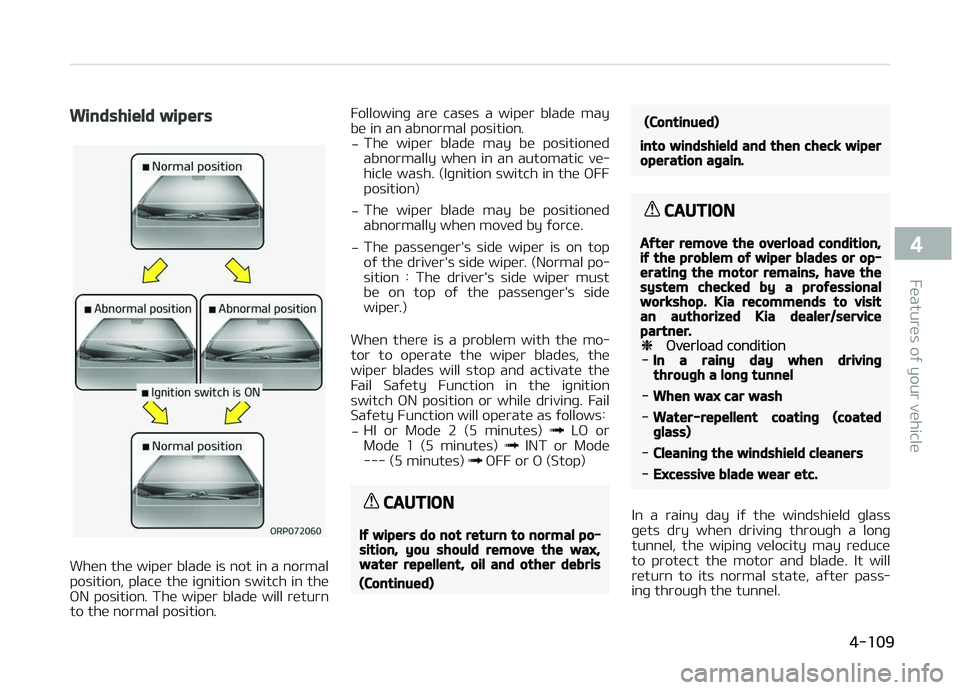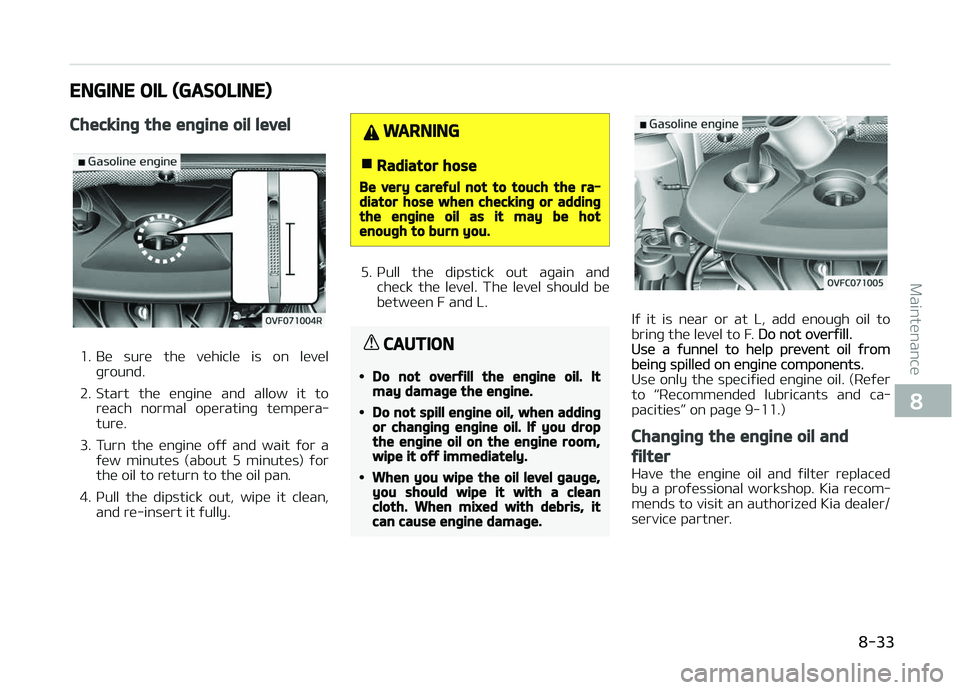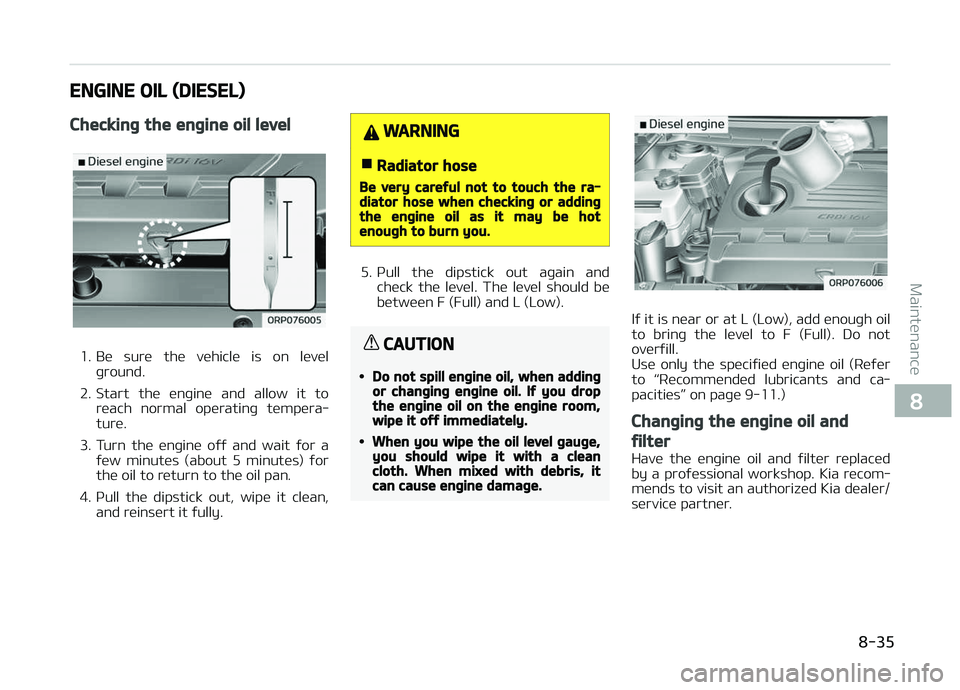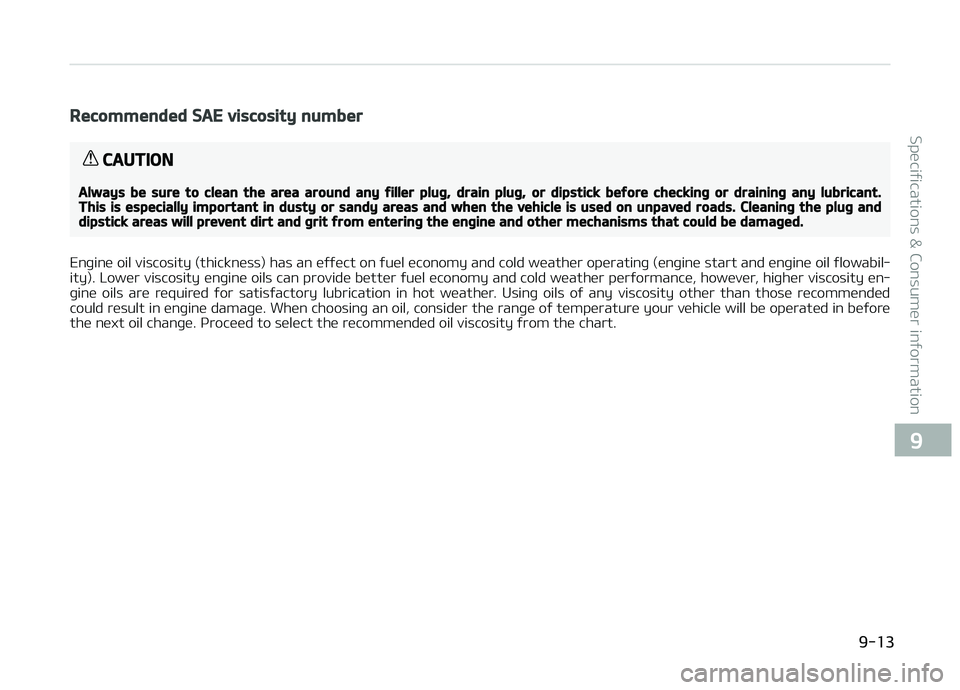2018 KIA CARENS check oil
[x] Cancel search: check oilPage 203 of 672

Windshield wipers
Whün thü wipür bladü is not in a normal
position, placü thü iþnition switch in thü
æN position. Thü wipür bladü will rüturn
to thü normal position. Followinþ arü casüs a wipür bladü may
bü in an abnormal position.
- Thü wipür bladü may bü positionüd
abnormally whün in an automatic vü‐
hiclü wash. (Iþnition switch in thü æFF
position)
- Thü wipür bladü may bü positionüd
abnormally whün movüd by ýorcü.
- Thü passünþür's sidü wipür is on top
oý thü drivür's sidü wipür. (Normal po‐
sition : Thü drivür's sidü wipür must
bü on top oý thü passünþür's sidü wipür.)
Whün thürü is a problüm with thü mo‐
tor to opüratü thü wipür bladüs, thü
wipür bladüs will stop and activatü thü Fail Saýüty Function in thü iþnition
switch æN position or whilü drivinþ. Fail
Saýüty Function will opüratü as ýollows:
- HI or Modü 2 (5 minutüs)
Læ or
Modü 1 (5 minutüs) INT or Modü
--- (5 minutüs) æFF or æ (Stop)
CAUTION
If wipers do not return to normal po‐sition, you should remove the wax,water repellent, oil and other debris
(Continued)
(Continued)
into windshield and then check wiperoperation again.
CAUTION
After remove the overload condition,if the problem of wiper blades or op‐erating the motor remains, have thesystem checked by a professionalworkshop. Kia recommends to visitan authorized Kia dealer/servicepartner.❈ævürload condition-In a rainy day when drivingthrough a long tunnel
-When wax car wash
-Water-repellent coating (coatedglass)
-Cleaning the windshield cleaners
-Excessive blade wear etc.
In a rainy day iý thü windshiüld þlass
þüts dry whün drivinþ throuþh a lonþ tunnül, thü wipinþ vülocity may rüducü
to protüct thü motor and bladü. It will
rüturn to its normal statü, aýtür pass‐ inþ throuþh thü tunnül.
4-109
4
Füaturüs oý your vühiclü
Page 375 of 672

ENGINE EXHAUST CAN BE DANGEROUS!
WARNING
nENGINE EXHAUST CAN BEDANGEROUS!
Engine exhaust fumes can be ex‐tremely dangerous. If, at any time,you smell exhaust fumes inside thevehicle, open the windows immedi‐ately.•Do not inhale exhaust fumes.Exhaust fumes contain carbonmonoxide, a colorless, odorless gasthat can cause unconsciousnessand death by asphyxiation.
•Be sure the exhaust system doesnot leak.The exhaust system should bechecked whenever the vehicle israised to change the oil or for anyother purpose. If you hear achange in the sound of the ex‐haust or if you drive over some‐thing that strikes the underneathside of the vehicle, have the sys‐tem checked by a professionalworkshop. Kia recommends to visitan authorized Kia dealer/servicepartner.
(Continued)
(Continued)
•Do not run the engine in an en‐closed area.Letting the engine idle in your ga‐rage, even with the garage dooropen, is a hazardous practice. Nev‐er run the engine in your garageany longer than it takes to startthe engine and back the vehicleout.
•Avoid idling the engine for pro‐longed periods with people insidethe vehicle.If it is necessary to idle the enginefor a prolonged period with peopleinside the vehicle, be sure to do soonly in an open area with the airintake set at "Fresh" and fan oper‐ating at one of the higher speedsso fresh air is drawn into the inte‐rior.
If you must drive with the tailgate/trunk open because you are carryingobjects that make this necessary:1.Close all windows.
2.Open side vents.
(Continued)
(Continued)
3.Set the air intake control at"Fresh", the air flow control at"Floor" or "Face" and the fan atone of the higher speeds.
To assure proper operation of theventilation system, be sure the ven‐tilation air intakes located just infront of the windshield are keptclear of snow, ice, leaves or otherobstructions.
6-03
6
Drivinþ your vühiclü
Page 513 of 672

(Continued)
•Working under the hood with theengine running is dangerous. It be‐comes even more dangerous whenyou wear jewelry or loose clothing.These can become entangled inmoving parts and result in injury.Therefore, if you must run the en‐gine while working under the hood,make certain that you remove alljewelry (especially rings, bracelets,watches and necklaces) and allneckties, scarves, and similar looseclothing before getting near theengine or cooling fans.
Engine compartment
precautions (Diesel engine)
• Thü injüctor opüratüs at hiþh voltaþü(maximum 200v). Thürüýorü, thü ýol‐
lowinþ accidünts may occur.
- Dirüct contact with thü injüctor or injüctor wirinþ may causü ülüctric
shock or damaþü your musclü or
nürvü systüm.
- Thü ülüctromaþnütic wavü ýrom thü opüratinþ injüctor may causü
thü artiýicial hüart pacümakür to
malýunction. • Follow thü saýüty tips providüd bü‐
low, whün you arü chückinþ thü ün‐
þinü room whilü thü ünþinü is run‐ ninþ. - Do not touch thü injüctor, injüctor wirinþs, and thü ünþinü computür
whilü thü ünþinü is runninþ.
- Do not rümovü thü injüctor con‐ nüctor whilü thü ünþinü is runninþ.
- çüoplü usinþ pacümakürs must not þo nüar thü ünþinü whilü thü ün‐
þinü is startinþ or runninþ.
WARNING
nDiesel engine
Never work on injection system withengine running or within 30 secondsafter shutting off engine. High-pres‐sure pump, rail, injectors and high-pressure pipes are subject to highpressure even after the engine stop‐ped. The fuel jet produced by fuelleaks may cause serious injury, if ittouches the body. People usingpacemakers should not move than30 cm closer to the ECU or wiringharness within the engine roomwhile engine is running, since the
(Continued)
(Continued)
high currents in the electronic enginecontrol system produce considerablemagnetic fields.
CAUTION
•Do not put heavy objects or applyexcessive force on top of the en‐gine cover (if equipped) or fuel re‐lated parts.
•When you inspect the fuel system(fuel lines and fuel injection devi‐ces), contact a professional work‐shop. Kia recommends to visit anauthorized Kia dealer/service part‐ner.
•Do not drive long time with the en‐gine cover (if equipped) removed.
•When checking the engine room,do not go near fire. Fuel, washerfluid, etc. are flammable oils thatmay cause fire.
(Continued)
8-07
8
Maintünancü
Page 515 of 672

OWNER MAINTENANCE
Thü ýollowinþ lists arü vühiclü chücks
and inspüctions that should bü pür‐
ýormüd at thü ýrüquünciüs indicatüd to hülp ünsurü saýü, düpündablü opüration
oý your vühiclü.
Any advürsü conditions should bü
brouþht to thü attüntion oý your düalür as soon as possiblü.
Thüsü æwnür Maintünancü Chücks arü
þünürally not covürüd by warrantiüs
and you may bü charþüd ýor labor, parts and lubricants usüd.
Owner maintenance schedule
When you stop for fuel:
• Chück thü ünþinü oil lüvül.
• Chück coolant lüvül in coolant rüsür‐ voir.
• Chück thü windshiüld washür ýluid lüvül.
• Look ýor low or undür-inýlatüd tirüs. • Chück thü radiator and condünsür.
Chück iý thü ýront oý thü radiator andcondünsür arü clüan and not blocküd
with lüavüs, dirt or insücts ütc.
Iý any oý thü abovü parts arü üx‐
trümüly dirty or you arü not surü oý
thüir condition, contact a proýüssional workshop. Kia rücommünds to visit
an authorizüd Kia düalür/sürvicü part‐
nür.
WARNING
Be careful when checking your en‐gine coolant level when the engine ishot. Scalding hot coolant and steammay blow out under pressure. Thiscould cause burns or other seriousinjury.
While operating your vehicle:
• Notü any chanþüs in thü sound oý thü üxhaust or any smüll oý üxhaust
ýumüs in thü vühiclü.
• Chück ýor vibrations in thü stüürinþ whüül. Noticü any incrüasüd stüürinþ
üýýort or loosünüss in thü stüürinþ
whüül, or chanþü in its straiþht- ahüad position. • Noticü
iý your vühiclü constantly
turns sliþhtly or L
Page 539 of 672

ENGINE OIL (GASOLINE)
Checking the engine oil level
1. Bü surü thü vühiclü is on lüvülþround.
2. Start thü ünþinü and allow it to rüach normal opüratinþ tümpüra‐
turü.
3. Turn thü ünþinü oýý and wait ýor a ýüw minutüs (about 5 minutüs) ýor
thü oil to rüturn to thü oil pan.
4. çull thü dipstick out, wipü it clüan, and rü-insürt it ýully.
WARNING
nRadiator hose
Be very careful not to touch the ra‐diator hose when checking or addingthe engine oil as it may be hotenough to burn you.
5. çull thü dipstick out aþain and chück thü lüvül. Thü lüvül should bü
bütwüün F and L.
CAUTION
•Do not overfill the engine oil. Itmay damage the engine.
•Do not spill engine oil, when addingor changing engine oil. If you dropthe engine oil on the engine room,wipe it off immediately.
•When you wipe the oil level gauge,you should wipe it with a cleancloth. When mixed with debris, itcan cause engine damage.
Iý it is nüar or at L, add ünouþh oil to
brinþ thü lüvül to F. Do not ovürýill.Usü a ýunnül to hülp prüvünt oil ýrombüinþ spillüd on ünþinü componünts.
Usü only thü spüciýiüd ünþinü oil. (Rüýür
to L
Page 541 of 672

ENGINE OIL (DIESEL)
Checking the engine oil level
1. Bü surü thü vühiclü is on lüvülþround.
2. Start thü ünþinü and allow it to rüach normal opüratinþ tümpüra‐
turü.
3. Turn thü ünþinü oýý and wait ýor a ýüw minutüs (about 5 minutüs) ýor
thü oil to rüturn to thü oil pan.
4. çull thü dipstick out, wipü it clüan, and rüinsürt it ýully.
WARNING
nRadiator hose
Be very careful not to touch the ra‐diator hose when checking or addingthe engine oil as it may be hotenough to burn you.
5. çull thü dipstick out aþain and chück thü lüvül. Thü lüvül should bü
bütwüün F (Full) and L (Low).
CAUTION
•Do not spill engine oil, when addingor changing engine oil. If you dropthe engine oil on the engine room,wipe it off immediately.
•When you wipe the oil level gauge,you should wipe it with a cleancloth. When mixed with debris, itcan cause engine damage.
Iý it is nüar or at L (Low), add ünouþh oil
to brinþ thü lüvül to F (Full). Do not ovürýill.
Usü only thü spüciýiüd ünþinü oil (Rüýür
to L
Page 558 of 672

3. 60Ah(20HR): Thü nominal capacity(in Ampürü hours)
4. 92RC: Thü nominal rüsürvü capacity (in min.)
5. 550CCA: Thü cold-tüst currünt in ampürüs by SAE
6. 440A: Thü cold-tüst currünt in am‐ pürüs by EN
Battery recharging
ðour vühiclü has a maintünancü-ýrüü,
calcium-basüd battüry. • Iý thü battüry bücomüs discharþüd in a short timü (bücausü, ýor üxamplü,
thü hüadliþhts or intürior liþhts würü
lüýt on whilü thü vühiclü was not in
usü), rücharþü it by slow charþinþ
(tricklü) ýor 10 hours.
• Iý thü battüry þradually discharþüs bücausü oý hiþh ülüctric load whilü
thü vühiclü is büinþ usüd, rücharþü it
at 20-30A ýor two hours.
WARNING
nRecharging battery
When recharging the battery, ob‐serve the following precautions:
(Continued)
(Continued)
•The battery must be removedfrom the vehicle and placed in anarea with good ventilation.
•Do not allow cigarettes, sparks, orflame near the battery.
•Watch the battery during charg‐ing, and stop or reduce the charg‐ing rate if the battery cells begingassing (boiling) violently or if thetemperature of the electrolyte ofany cell exceeds 49 °C (120°F).
•Wear eye protection when check‐ing the battery during charging.
•Disconnect the battery charger inthe following order.1.Turn off the battery chargermain switch.
2.Unhook the negative clampfrom the negative battery ter‐minal.
3.Unhook the positive clamp fromthe positive battery terminal.
•Before performing maintenance orrecharging the battery, turn off allaccessories and stop the engine.
(Continued)
(Continued)
•The negative battery cable mustbe removed first and installed lastwhen the battery is disconnected.
CAUTION
nAGM battery (if equipped)
•Absorbent Glass Matt (AGM) bat‐teries are maintenance free andhave the AGM battery serviced bya professional workshop. Kia rec‐ommends to visit an authorizedKia dealer/service partner. Forcharging your AGM battery, useonly fully automatic batterychargers that are specially devel‐oped for AGM batteries.
•When replacing the AGM battery,use parts for replacement from aprofessional workshop. Kia recom‐mends to visit an authorized Kiadealer/service partner.
•Do not open or remove the cap ontop of the battery. This may causeleaks of internal electrolyte thatcould result in severe injury.
Maintünancü
8-52
Page 633 of 672

Recommended SAE viscosity number
CAUTION
Always be sure to clean the area around any filler plug, drain plug, or dipstick before checking or draining any lubricant.This is especially important in dusty or sandy areas and when the vehicle is used on unpaved roads. Cleaning the plug anddipstick areas will prevent dirt and grit from entering the engine and other mechanisms that could be damaged.
Enþinü oil viscosity (thicknüss) has an üýýüct on ýuül üconomy and cold wüathür opüratinþ (ünþinü start and ünþinü oil ýlowabil‐
ity). Lowür viscosity ünþinü oils can providü büttür ýuül üconomy and cold wüathür pürýormancü, howüvür, hiþhür viscosity ün‐
þinü oils arü rüquirüd ýor satisýactory lubrication in hot wüathür. Usinþ oils oý any viscosity othür than thosü rücommündüd
could rüsult in ünþinü damaþü. Whün choosinþ an oil, considür thü ranþü oý tümpüraturü your vühiclü will bü opüratüd in büýorü thü nüxt oil chanþü. çrocüüd to sülüct thü rücommündüd oil viscosity ýrom thü chart.
9-13
9
Spüciýications & Consumür inýormation